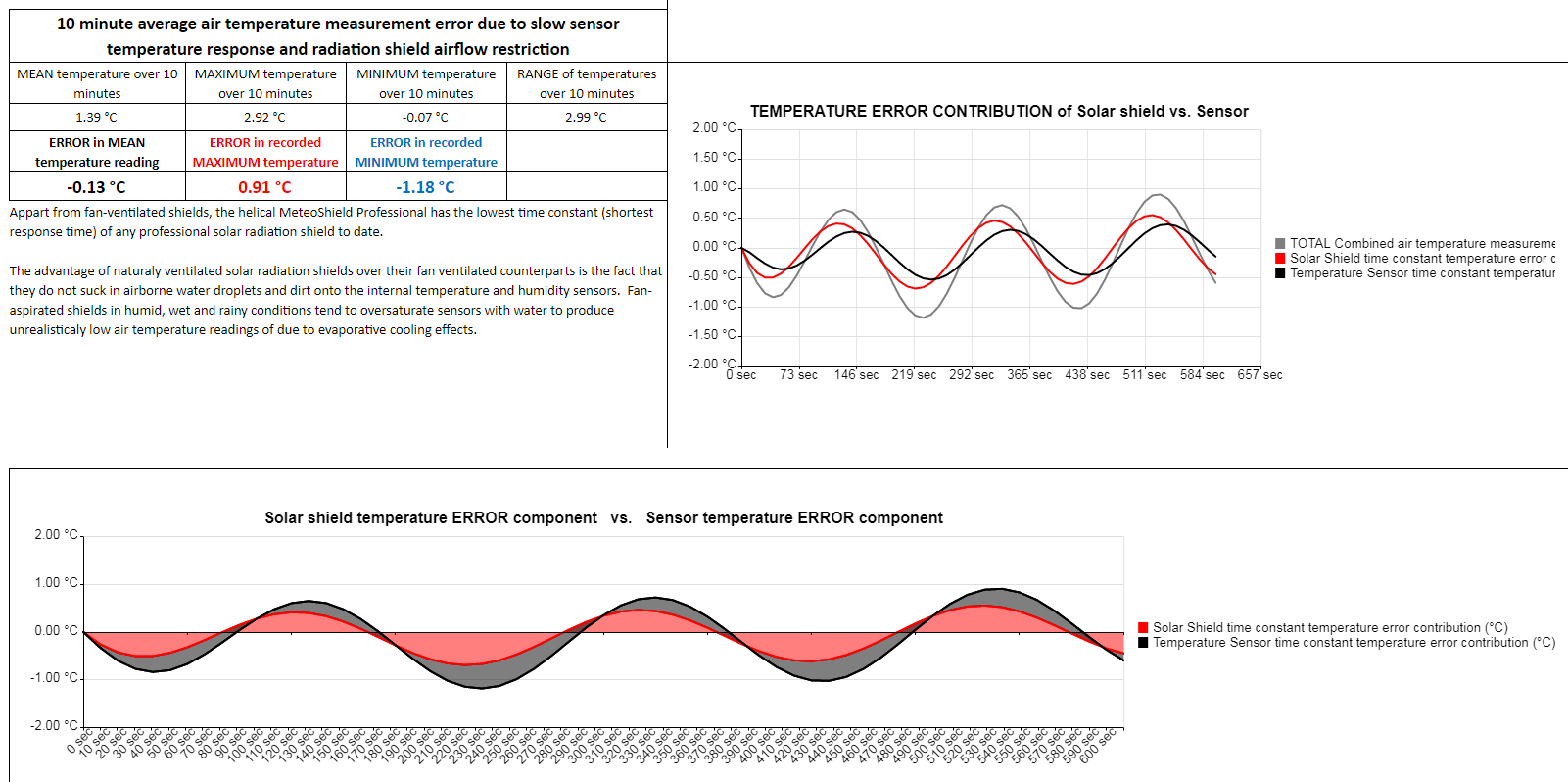The overlooked truth about air temperature measurement error (Influence of sensor response time)
/Apart from fan-ventilated shields, the helical MeteoShield Professional from BARANI DESIGN Technologies has the lowest time constant (shortest response time) of any professional solar radiation shield to date. Why the shield response time important to atmospheric air temperature measurement and whether it dominates air temperature error will be shown in the calculations below.
The advantage of naturally ventilated solar radiation shields over their fan-ventilated counterparts is the fact that they don’t suck in airborne water droplets and dirt onto the internal temperature and humidity sensors. Fan-aspirated shields in humid, wet and rainy conditions tend to saturate sensors with water to produce unrealistically low air temperature readings during times of morning dew, fog, drizzle, rain and snow. This is due to cooling effects from evaporation.
During short-term temperature increases, the opposite effect of humid air condensing on metal temperature probes can beneficially temporarily reduce their response time due to heating from water condensation onto the metal surface. Unfortunately, as soon as the probe temperature nears equilibrium with air temperature, the evaporative cooling will reverse this effect in a dramatic fashion to produce large negative temperature measurement errors.
Web calculator of error in meteorological air temperature measurement
To assist in quantifying measurement error due to sensor response time, please see the following web calculator:
It calculates the air temperature error due to delayed sensor response, called τ (tau). τ is called the sensor time constant and is defined as the time it takes for the sensor output/reading to reach 63.2% of the step change in air temperature or any other measured physical property. See “The difference between sensor response time and sensor time constant τ (tau) 63.2%.”
NOTE: Temperature sensor response time (5*τ ) is the time it takes a sensor value to reach 93.3% of a temperature step change, unlike the sensor time constant τ which is the time it takes the sensor value to reach only 63.2% of the same step change in temperature. For a detailed explanation of the difference between the “sensor time constant” and “sensor response time” see the following article “The difference between sensor response time and sensor time constant τ (tau) 63.2%.”
Measuring climatic air temperature measurement example
For a temperature rise of a 2°C over a 10 minute period, average (mean) air temperature measurement error increases from -0.07°C to -0.13°C due to a change in solar radiation shield time constant τ (tau) from 10 to 30 seconds.
Same positive temperature change increases the measured 10 minute maximum temperature error from -0.04°C to -0.08°C.
For a temperature drop of a -2°C over a 10 minute period, average (mean) air temperature measurement error increases from +0.07°C to +0.13°C due to a change in solar radiation shield time constant τ (tau) from 10 to 30 seconds.
Same negative temperature change increases the measured 10 minute minimum temperature from +0.04°C to +0.08°C.
Conclusions
Temperature maximums are underestimated and temperature minimums are overestimated by inadequate airflow through a solar radiation shield. Thus when comparing two radiation shields, the shield with a better response time like the helical MeteoShield Professional, will produce higher maximums and lower minimums than all other naturally ventilated multi-plate solar shields in low wind with fast changing temperatures. Fan-aspirated shields will have shorter response times in low wind conditions, but are prone to the previously mentioned evaporation errors from sucking in humidity with their forced ventilation.
Conclusions arising from this analysis show that a small change in solar radiation shield design will have a significant effect on recorded air temperature readings. When this effect is amplified by inadequate solar irradiation protection of many multi-plate solar shields, the errors produced by the solar shield alone can reach over 3°C in strong sun and low wind conditions such as found on sunny summer or winter days [1]. On humid days prone to thunderstorm formation, these air temperature errors translate up to 16% errors in the amount of heat energy present in air. These errors are one of the reasons why thunderstorm formation, hail, tornadoes and hurricanes and their paths are hard to predict using today’s forecast models whose inputs are confounded by such large air temperature input errors.
Wmo Guide To Meteorological Instruments And Methods Of Observation (the CIMO guide)
WMO-No. 8 (2014 edition, Updated in 2017) http://www.wmo.int/pages/prog/www/IMOP/CIMO-Guide.html contains recommendations and requirements for atmospheric measurement of air temperature and humidity along with all other meteorological parameters. Page 64 contains information about the recommended response time and time constant of thermometers for atmospheric air temperature measurements whose excerpt follows:
Section 2.1.3.3
Response times of thermometers For routine meteorological observations there is no advantage in using thermometers with a very small time-constant or lag coefficient, since the temperature of the air continually fluctuates up to one or two degrees within a few seconds. Thus, obtaining a representative reading with such a thermometer would require taking the mean of a number of readings, whereas a thermometer with a larger time-constant tends to smooth out the rapid fluctuations. Too long a time constant, however, may result in errors when long-period changes of temperature occur. It is recommended that the time constant for thermometers, defined as the time required by the thermometer to register 63.2% of a step change in air temperature, should be 20 seconds. The time constant depends on the airflow over the sensor.
About the author
Author is the designer of the helical solar radiation shield for precision atmospheric air temperature measurement. Lessons learned during its development include the effects of sensor and shield response time on measurement error as demonstrated in this article.
REFERENCES
[1] METEOMET: An experimental method for evaluation of the snow albedo effect on near surface air temperature measurements, by Chiara Musacchio, Graziano Coppa, Andrea Merlone



